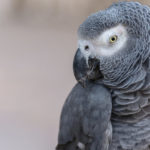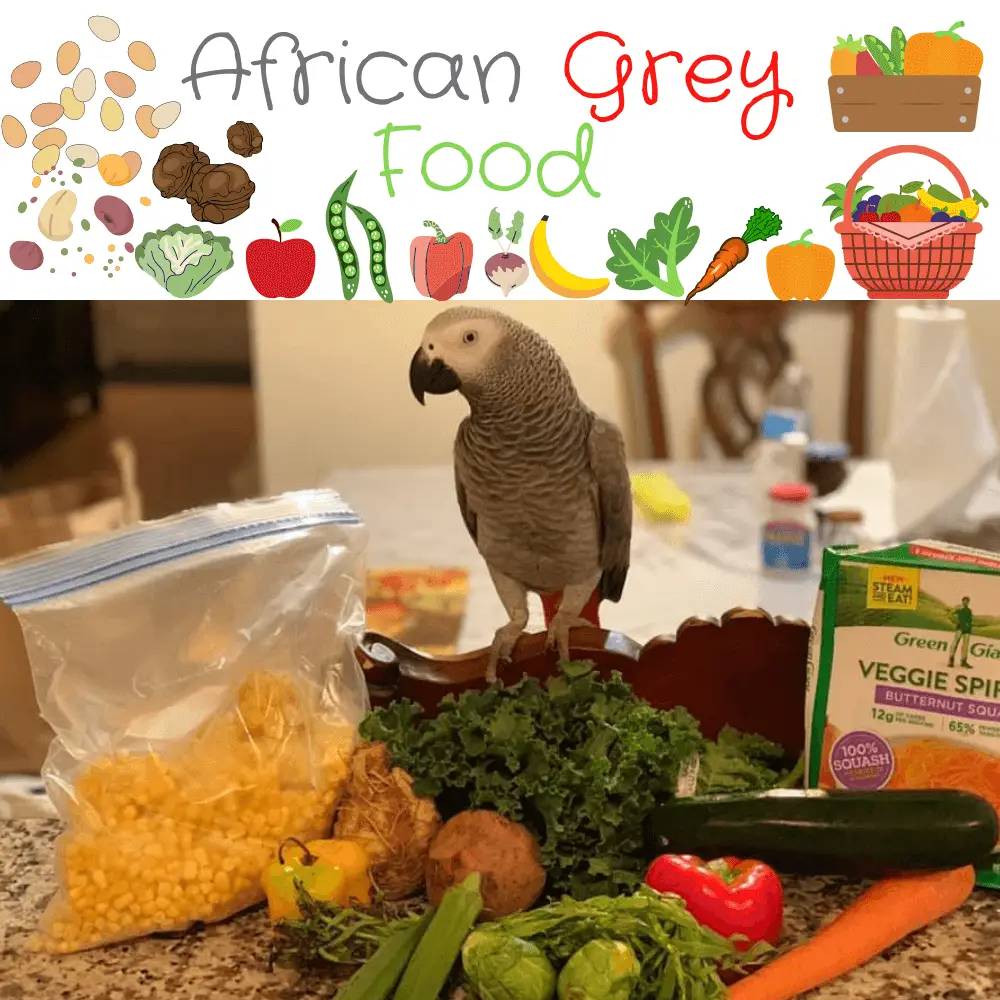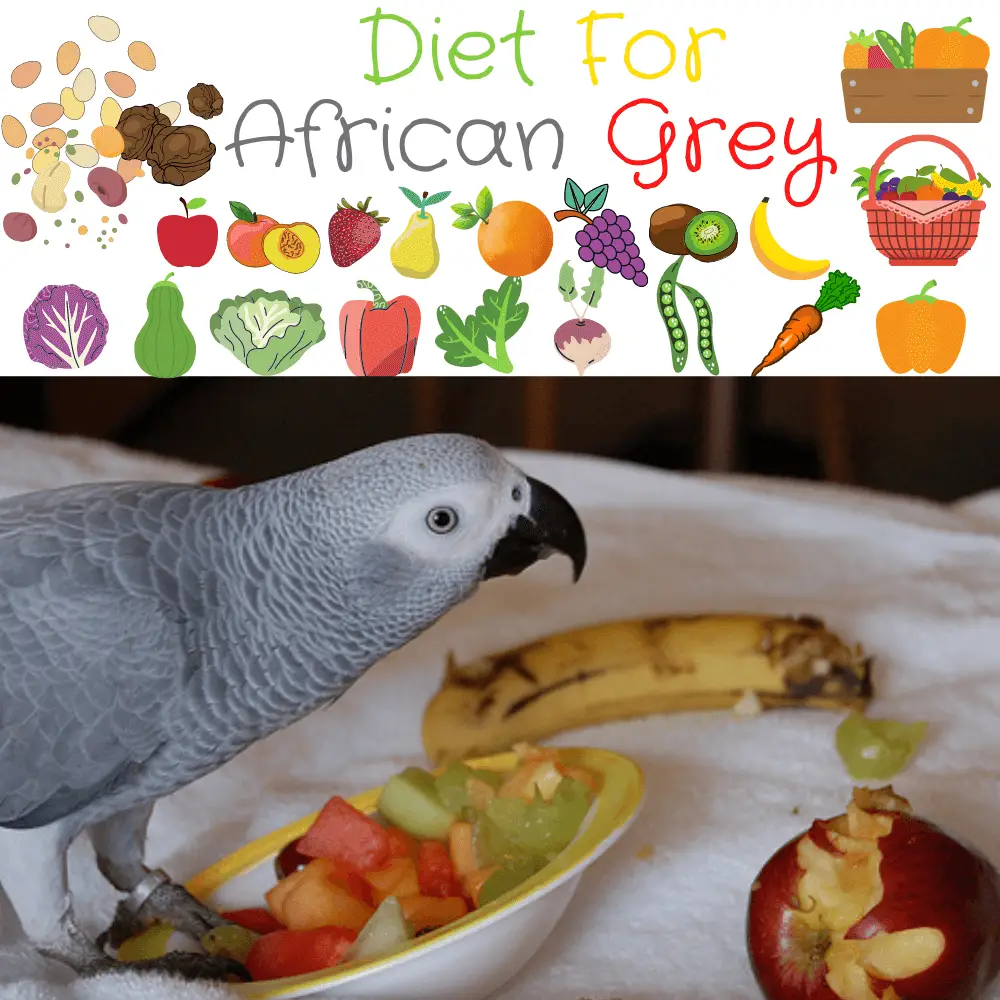African grey food: The Congo African grey parrot is a frugivorous and granivorous bird, that is to say, its diet does not contain any animal protein and its diet will be mainly composed of seeds and cereals. Be careful, the food mixture should not be given in an anarchic way, because the aviary parrot does not practice the same physical effort as that in the wild.
Lipid intake must therefore be controlled, so, even if I am particularly fond of it, fatty nuts such as peanuts (peanuts), hazelnuts … or sunflower seeds should be given very sparingly. Preferably choose mixtures of seeds poor in sunflowers, and whose contribution will avoid deficiencies in the bird.
In general, the healthy adult parrot eats 40g of daily ration divided into 2 meals. This ration will be composed of a mixture of fresh fruits and vegetables, dry seeds, sprouted seeds (richer in protein), and cereals. It is recommended to opt for an extruded form of granules, all the nutritional contributions will be concentrated in a mixture of croquettes which will prevent the bird from sorting and therefore being deficient in vitamins and minerals. To this, we can also add food supplements to the drink. Water must be served constantly, renewed daily, (an adult parrot drinks 20 ml per day on average).
African grey parrot food
SOURCE:wingsNpaws
- Plantain, you will find it in the meadows (beware of pesticides and others)
- Chickweed or chickweed
- Dandelion
Some vegetables are very important:
- Spinach
- Lamb’s lettuce
- The carrot
- The tomato
Fruits in small quantities:
- Apple
- The kiwi
- Orange
- Blackberries, raspberries
- The pear
- The watermelon
- Fresh fig is an excellent food
- Cherries without pits
The cereals :
- Alpe
- Millet
- But
- Corn
- Spelled
- Sarazin
- Oats
- Paddy rice
What not to give:
Toxic foods for African Grey parrot
Foods That Parrots Should NOT Eat
- Chocolate
- Avocado
- Caffeine
- The alcohol
- Apple seeds, kernels of all kinds (because they contain cyanide)
- Products containing lactose
- Garlic and onions, cooked or raw
- Salt
Diet for African grey
A good basic diet will contribute to the good health of your Grey
No bird should be fed exclusively dry seeds. Indeed the seeds are poor in amino acids (proteins) as well as vitamins and minerals. In addition, your parrot will tend to favor the oiliest seeds and will leave others aside, leading irremediably to serious deficiencies. I am thinking in particular of vitamin A and beta-carotene, which in case of lack will lead to hypovitaminosis A in your Grey, affecting the lungs and the digestive system.
Your gray will also be sensitive to the lack of vitamin D.3 and calcium, which combined with a lack of sunlight, will lead to hypocalcemia. It is therefore very important to cover its nutritional need and keep your Grey healthy, to add protein and other nutritious foods.
Personally, I strongly advise against giving him human food. Even if the latter would appreciate without complaining, his body is not made for this kind of food. Fats, salt, vinegar, etc., could be harmful to him in the more or less long term.
It is also useful for me to remind you that our African Parrot has more than 400 taste buds. The obvious importance of his language, therefore, is to taste the food before its approval.
I will detail in 3 chapters, their main diets, always embellished of course with seasonal fruits and greens because they are foods rich in manganese and vitamins, useful in the formation of feathers and growth of young birds. Note that it is your Parrot who will choose his food and not you who will impose on him.
Basic diet commercial
seed mixture Oilseeds: Peanuts, carder, safflower, hemp, rapeseed, poppy seeds, flax, niger, perilla, pumpkin, sunflower. Cereals: Canary seed, shelled oats, corn, wheat, millet, paddy. A well-balanced seed mixture for your Parrot will consist as follows: About 20% canary seed, 15% shelled oats, 20% Bordeaux millet, Japanese, etc., 30% black and white sunflowers, 1% peanuts It will be important to choose a recognized and reliable supplier, thus minimizing the risk of introducing into your farm, a very harmful and relatively common mold “Aspergillus” (Aspergillosis).
Extruded
granules are usually made from a mixture of cereals and oilseeds (corn, wheat, rice, soybeans, peanuts), carrots, vegetable oils, vitamins, minerals, trace elements, and fruit flavor.
They do not contain animal protein or dyes. They are also enriched with fructooligosaccharides, soluble dietary fibers that only certain bacteria such as lactobacilli can metabolize.
These germs that live naturally in the intestine produce volatile fatty acids that acidify the intestinal environment, limiting the proliferation of pathogenic bacteria, thus making birds more resistant to diseases. In addition, this flora plays an important role in the assimilation of certain nutrients.
They are manufactured according to the processes of extrusion, which cooks the ingredients at a very high temperature for a very short time. The advantages of this technique are numerous:
Cooking makes the food more digestible – The food is devoid of germs and pathogenic fungi – The granules hold up very well, so fewer losses. – Vitamin A 12000 I.U./kg – Vitamin D3 1200 I.U/kg – Calcium 1% per kg
These are therefore complete foods that provide a healthy and balanced diet.
Reading the list of elements contained in pellets, it becomes clear that they provide nutrients that are often lacking in industrial avian feed. Ex: Spirulina delivers a powerful dose of protein and vitamin A. Psyllium helps with digestion (by removing toxins along the digestive tract).
Wheat germs provide vitamin E, an antioxidant and anti-inflammatory used by parrots in several ways. Alfalfa, the “miracle product” of herbalists, contains essential nutrients. Selenium, a vital ingredient that is often forgotten in parrot food, acts like vitamin E as a powerful antioxidant and mood stabilizer.
Together they play an essential role in the “making” of feathers, bone formation, and fertility But never forget that it is your parrot that will decide its food and not you who should decide for it. Do not hesitate to try several kinds of granules, or even mix several. Without forgetting of course the essential daily intake of fruits and vegetables.
Additional
contribution My African Grey, have regularly at their disposal a mixture of pigeon seeds previously soaked 24 hours in the water, thus promoting the tenfold increase of vitamins during the germination phase.
you can see in the photo below, rosehip seeds, rich in vitamin C offered with pigeon seeds- Cuttlefish bone and iodine block that will contribute to the intake of minerals and calcium and iodine. Iodine deficiency can lead to a clear slowdown in molting in some Psittacidae.
– Fruits and vegetables given will be Apples, pears, apricots (rich in vitamin A) grapes, pomegranates, melon, carrot, cruciferous, dandelion, cabbage leaf, cucumber, etc. This list is of course not exhaustive, but only spinach, avocados, and citrus fruits are to be avoided. -An intake of vitamins in powder form to be added to the daily ration, can be provided during the molting period or to a convalescent bird.
prefer powdered vitamins that will keep for about 2 years, in a compartment of your fridge away from light, to active soluble powder maximum of 6 months, Different brands on the market today
Storage of Granules
My granules and seeds are kept in a 5-liter seal hermetically sealed after each use. Limiting the risk of mold, and proliferation of rodents.
Note: This article only engages me, I am neither nutritionist nor a veterinarian, but simply an individual passionate about hooked beaks and especially Congo African Grey. This article has been written without any pretension, but simply with the aim of helping you better feed your African Parrot. Extending his life expectancy by the same token.
Related Post:






















